
Nevalı Çori was an early Neolithic settlement on the middle Euphrates, in Şanlıurfa Province, Southeastern Anatolia, Turkey. The site is known for having some of the world's oldest known temples and monumental sculpture. Together with the earlier site of Göbekli Tepe, it has revolutionised scientific understanding of the Eurasian Neolithic period. The oldest domesticated Einkorn wheat was found there.
Anatolian or anatolica may refer to:

Tushhan is a Kurdish village known as or by residents. It was an ancient city in Mesopotamia and was a provincial capital in the upper Tigris river valley, on the south bank and inhabited since the Mitanni period, and mainly during the Neo-Assyrian period during the Iron Age.
Celaenae (Celænæ) or Kelainai, was an ancient city of Phrygia and capital of the Persian satrapy of Greater Phrygia, near the source of the Maeander River in what is today west central Turkey, and was situated on the great trade route to the East.

Orchis is a genus in the orchid family (Orchidaceae), occurring mainly in Europe and Northwest Africa, and ranging as far as Tibet, Mongolia, and Xinjiang. The name is from the Ancient Greek ὄρχις orchis, meaning "testicle", from the appearance of the paired subterranean tuberoids.

Archelaus was a Roman client prince and the last king of Cappadocia.

Alishar Hüyük was an ancient Near Eastern city. It is near the modern village of Alişar, Sorgun.
Pyrus anatolica is a species of plant in the family Rosaceae. It is endemic to Turkey.
Hüseyindede Tepe is an Early Hittite site in the Sungurlu district of Turkey's Çorum Province, about 2 km south of a town called Yörüklü. The site has been surveyed in 1997, leading to the discovery of the Hüseyindede vases, one of which depicts dancers and processions and the other of which shows thirteen figures, with two in the act of somersaulting over a bull. A third Hittite vase depicting dancers, musicians and acrobats was found in İnandık. The artwork is in Anatolian style and not an import from Minoan Crete, the area mostly associated with bull-leaping.

Orchis anatolica is a species of flowering plant in the Orchidaceae family. It is native to Crete, Cyprus, the East Aegean Islands, Greece, Iran, Iraq, Lebanon, Palestine, Syria, and Turkey.

Anaesthetis testacea is a species of longhorn beetle. It is a common species in Europe that develops in the dead, terminal twigs of deciduous trees and shrubs.
Glaphyra was a hetaera, a form of courtesan, who lived in the 1st century BC. Glaphyra was famed and celebrated in antiquity for her beauty, charm and seductiveness. Her marriage to Archelaus the elder of Cappadocia gave her political power. Her later affair with Mark Antony occasioned a vulgar poem from Octavian Caesar.
Jordanita anatolica is a moth of the family Zygaenidae. It is found in Nakhchivan, southern Turkey, Cyprus, Syria, Lebanon, Israel, Jordan, Egypt and north-eastern Libya. In the east, the range extends to Iraq and Iran.

Morchella anatolica is a rare species of ascomycete fungus in the family Morchellaceae. It was described as new to science in 2010 from southwest Anatolia, Turkey, where it grows on moss-covered stream beds in pine forests. An ancient climatic relict, M. anatolica is restricted to the Mediterranean basin and has also been documented in Spain, Cyprus and Greece, where it is sometimes encountered with trees of the Oleaceae family. Together with its sister-species Morchella rufobrunnea, they are the earliest diverging lineages in genus Morchella, forming a distinct clade that is basal in global morel phylogenies. Because of its phylogenetic position, M. anatolica has been crucial in inferring the historical biogeography of the genus, which is estimated to have emerged somewhere in the Mediterranean region in the late Jurassic.
Anaesthetis confossicollis is a species of beetle in the family Cerambycidae. It was described by Baeckmann in 1903. It is known from Russia, China, Mongolia, Siberia and Japan.
Anaesthetis flavipilis is a species of beetle in the family Cerambycidae. It was described by Baeckmann in 1903. It is known from Kazakhstan, Russia, Siberia, and China.
Anaesthetis lanuginosa is a species of beetle in the family Cerambycidae. It was described by Baeckmann in 1903. It is known from Central Asia and Iran.
Anaesthetis lepida is a species of beetle in the family Cerambycidae. It was described by Ernst Friedrich Germar in 1848. It is known from Australia.

Vipera anatolica, commonly known as the Anatolian meadow viper, is a species of venomous snake of the family Viperidae.
Cephalaria anatolica, is a herbaceous plant, native to elevations of 1000 meters height.








